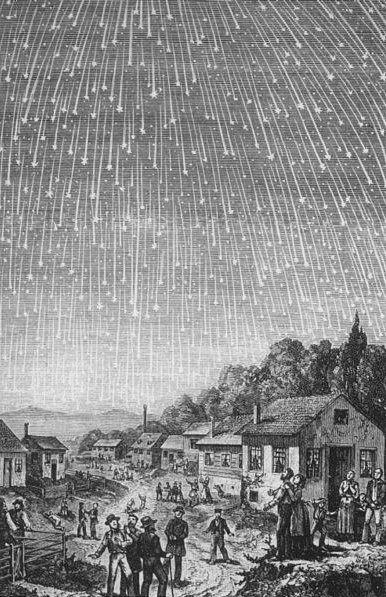|
8. I suggest there is a possibility that meteor showers from Leo could have generated an idea that 33 was a number outside the ordinary flow of events, and that consequently 33 may have been integrated in (grafted onto) the old system as a number symbol for a break in time - such as the downfall or birth of a king.  A rain of fire could easily have been interpreted as a descent of 'living spirits' (manu rere) rushing down in order to occupy new 'houses' (the waiting bodies of the unborn). New houses should be built in time for summer solstice (cfr at Ure Honu):
We can also recall the complaint of the Loon: ... The Loon was calling, and the old man who at that time bore the Raven's name, Nangkilstlas, asked her why. 'The gods are homeless', the Loon replied. 'I'll see to it', said the old man, without moving from the fire in his house on the floor of the sea ... But Regulus (the Little King) is rising heliacally 2 months beyond winter solstice, clearly beyond the carpenter's work with the new 'house':
The heliacal rising is in the 2nd half of August - not in the 2nd half of November when the Leonids appear. The timing seems to be a quarter out of phase. But we should change the time of observation in order to see the shower - when Regulus is rising together with Sun it is impossible to see the falling stars:
When rising heliacally Regulus is together with Sun all through the day and descends in the west together with Sun. Some time later, though, Sun has moved ahead and Regulus is now descending later than Sun - it has become night and Leo can be seen above the horizon in the west, at first only for a short while before descending but gradually the time of visibility will increase. Is it possible to detect any trace of the Leonids where we could suspect them to be in the G text, viz. not at the heliacal rising of Regulus but in the 2nd half of November? A tentative map so far - cfr in Antipodal Stars - should have them in the quarter between mago in Gb2-10 and December 21:
Allen states: 'From a point a little to the west of ζ, and not much farther from γ, issue the Leonids, the meteor stream of November 9th to 17th, its maximum now occurring on the 13th-14th ...' Thus we should search around glyph number 266 + (30 - 22) + 31 + 13 = 318:
The glyph period from November 9 to November 17 (as I have preliminary defined the dates in the text) do indeed seem to constitute a unit, ending in darkness ('death'). From the reversed hau tea in Gb4-1 up to and including the similarly reversed hau tea in Gb5-1 there are 33 days. There is a pair of non-reversed hau tea at the heliacal rising of Regulus and a pair of reversed hau tea beyond the π glyph:
|
|||||||||||||||||||||||||||||||||||||||||||||||||||||||||||||||||||||||||||||||||||||||||||||||||||||||||||||||||||||||||||||||||||||||||||||||||||








